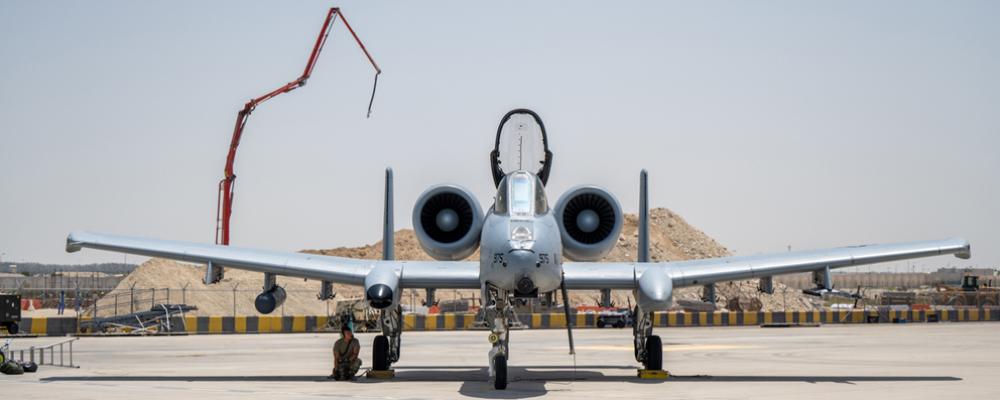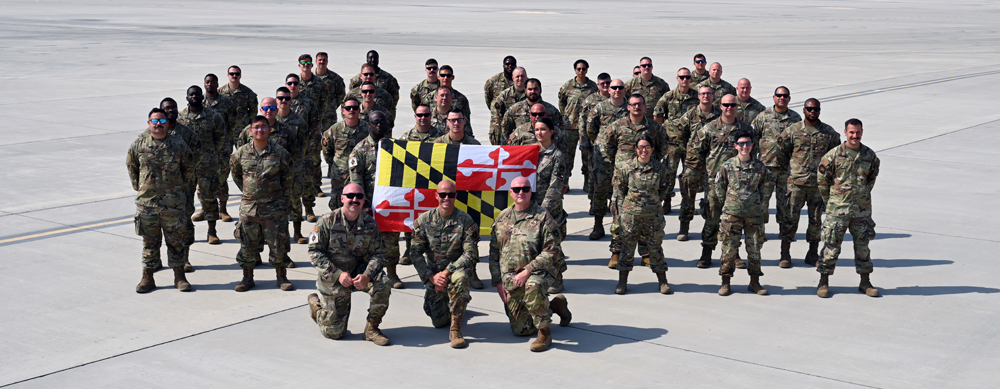
Still Lethal, Still Ready
In early July, about 300 members of the Maryland National Guard’s 175th Wing returned from a successful deployment to the Middle East. Having conducted seven previous deployments since 9/11, the A-10s in the wing’s 104th Fighter Squadron were “old-hats” at conducting combat operations in the region.
Yet this deployment was unlike the wing’s previous seven. The 175th only had a few months to prepare, and the range of missions forced it to operate simultaneously from two locations hundreds of miles apart.
Eleven days before the deployment, the Air Force announced in a March 7 statement that Maryland’s A-10s would be divested in 2025, meaning the 175th’s mission of providing combat air power would be replaced by a nonflying cyber operations mission.
Per the Air Force, this divestment of the 175th’s 21 A-10s could begin as early as next fiscal year. Debate for the plan is ongoing and still pending congressional approval. The decision will be included in the fiscal 2025 National Defense Authorization Act.
Martin State’s manpower numbers are expected to remain neutral, and the base isn’t precluded from other potential missions in the future. The Department of the Air Force will next conduct an environmental impact analysis for the cyber wing at Martin State, which is expected to finish in fall 2025.
The impact of the A-10 is the support we provide the troops on the ground, who are often Marines and Army guys, and who in their darkest hour need some kind of coverage to suppress enemy fire.
—1st Lt. Joanna Voss, the installation deployment officer for the wing's 175th Logistics Readiness Squadron
THE AIR FORCE’S ANNOUNCEMENT came before a major deployment for the 175th and its A-10s. While in the Middle East, the 175th’s pilots, maintainers and staff operated as the 104th Expeditionary Fighter Squadron out of the 380th Air Expeditionary Wing and the 332nd Air Expeditionary Wing.
They supported three ongoing U.S. Central Command operations during their more than 100 days in theater: Inherent Resolve, Spartan Shield and Poseidon Archer. According to Lt. Col. Chris “Slug” Palmer, the 104th’s commander, the squadron’s pilots logged roughly 4,000 combat hours during some 900 combat sorties.
Most of the action supported OIR, which aims to counter the Islamic State in Iraq and Syria, provide regional stability in eastern Syria and western Iraq and curb terrorism. OSS missions focused on freedom of navigation in the Arabian Gulf and the Gulf of Oman. OPA sorties helped defend the Red Sea against the Houthis, an Islamic political and military organization operating in Yemen.
“The 104th EFS was highly successful at close-air support, agile combat employment and partner-nation integration missions,” Palmer says.
Squadron personnel were in the region when Iran launched a massive one-way drone attack against Israel on April 13. Palmer says this attack demonstrated the importance of their work promoting regional stability in CENTCOM’s area of responsibility. “It framed the urgency of the mission,” he recalls. “It gave people a purpose.”
“As a whole,” Palmer says, “the entirety of the expeditionary wings that were out there played a critical role in protecting Israel and preventing civilian casualties.”
The unit also participated in two exercises while in the Middle East: Desert Flag 2024 and Eager Lion 2024.
Desert Flag 2024 involved the United States and nine other countries operating 12 different aircraft from an undisclosed location April 21 to May 10. A U.S. Air Forces Central press release described Desert Flag as a Red Flag-style exercise that enabled the participating countries to execute some of their primary mission sets, including close air support, forward air control and combat search and rescue.
“We are all wanting to perfect our craft and the tactical execution of our mission sets,” one unnamed Maryland Air Guard A-10 pilot said in the release. “Being able to coordinate and work closely together to work towards that helps build the relationships that are required to operate effectively as a coalition.”
Jordan hosted Eager Lion 2024 from May 16-23. The United States and more than 30 other partner nations participated. Exercise scenarios involved challenges across the region’s air, land, sea and cyber domains, while supporting humanitarian aid assistance and multinational disaster response operations, according to the Pentagon.
“Lethality is an aggressive, decisive attitude that attack pilots utilize to maximize weapons employment effects to meet the ground forces commanders’ intent,” Palmer says of the 104th’s attitude during its latest deployment.
“The A-10 can be relevant to increased firepower with some of our longer-range munitions that we can drop now,” he adds of what the 175th’s deployment demonstrated about its A-10s. “When packaged appropriately, it can be quite effective against certain near-peer adversary threats.”

THE 175TH’S AIRMEN RETURNED to the United States proud of their accomplishments, eager to continue serving their country and Maryland, yet apprehensive about their future role in national defense. The 175th currently has the 175th Cyber Operations Group, and its leadership strongly supports expanding that mission while transitioning to a future fighter mission.
The 175th has been a flying unit since 1921. It has been operating A-10s at Martin State Air National Guard Base in Middle River, just outside of Baltimore, since 1979.
Unit members understand the A-10’s long, glorious career is nearing retirement. Affectionately known as the Warthog for its odd shape, the A-10 was the close-air-support star of the first Persian Gulf War in 1991 and the Global War on Terror.
Protected from most groundfire by what amounts to a titanium bathtub, A-10 pilots can fly low and slow enough over the battlefield to see and target enemy troops, who were known to run from the distinctive BRRRT sound of the aircraft’s 30mm Gatling gun.
Many U.S. ground troops believe they are alive today thanks to the A-10. One is the brother of 1st Lt. Joanna Voss, the installation deployment officer for the wing’s 175th Logistics Readiness Squadron. She recalls a call with her brother in 2018. In Iraq at the time, the Army officer told her an A-10 had saved his life earlier that day.
“The impact of the A-10 is the support we provide the troops on the ground, who are often Marines and Army guys, and who in their darkest hour need some kind of coverage to suppress enemy fire,” Voss says. “I personally like to think it is one of the most dangerous aircraft to fly due to its proximity to real, physical danger.”
Despite the fighter’s storied legacy of supporting troops on the ground, the Air Force is aggressively divesting the A-10 as a cost-savings measure so that the service can focus on deterring and winning a fight against China.
Maryland marks the first spot impacted by the Air Force’s decision to gradually phase out its entire A-10 fleet nationwide. Besides the 175th, the Idaho Guard’s 124th Wing and the Michigan Guard’s 127th Wing also fly the airframe. In May 2023, Air Force Secretary Frank Kendall told Congress he would try replacing the A-10 with other flying missions when possible. The same year, the Air Force also announced the F-16 Fighting Falcon will replace the 124th’s A-10 fighters in 2027. But despite Kendall’s pledge, the Maryland and Michigan Guard units don’t have another airframe for now.
According to Palmer, the airmen of the 175th are eager to be a part of this decision and hope to do so in another fighter. The 104th is one of only 25 fighter squadrons in the Air Guard, and its vast wealth of talent and experience is considered by many to be a national asset. These strategic assets, built over decades of flying fighters, deliver twice the experience at roughly half the cost of their regular Air Force counterparts.
“The dedication, skill and professionalism our Maryland Air National Guard airmen exhibit is second to none,” says Col. Richard Hunt, the 175th’s wing commander. “Their knowledge and experience make our wing well prepared for a future flying mission. This deployment truly showcased that our airmen could get the mission done exceptionally well amid the challenges they faced.”
While uncertain about the future, the men and women of the 175th Wing remain lethal and ready for their nation’s call. As Palmer emphasizes, “At the end of the day, we just have to go out and execute. We’ve got to be lethal when the time is right.”
Mark Hensch is the NGAUS senior writer/ editor. He can be reached at mark.hensch@ngaus.org.
OUR TAKE

Air National Guard fighter recapitalization, the replacement of legacy combat aircraft the Air Force wants to divest, is a NGAUS priority. Guard legacy aircraft contribute to Air Force combat capacity, and their units have some of the service’s most experienced pilots and maintainers. The nation and the Air Force cannot afford to lose these personnel at a time when both are in short supply.
Nevertheless, the Air Force has yet to provide a plan to replace the Air Guard’s full legacy fleet. In fact, the service’s plans to squander talented Air Guard talent are moving forward. To maintain combat capacity and retain scarce pilots and maintainers, the association seeks accelerated recapitalization of all Guard fighter units with new-build aircraft.
The Air Guard has 25 fighter squadrons. The nation needs the Air Guard to maintain 25 fighter squadrons.



